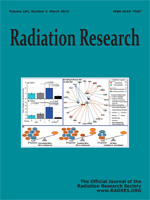Prenatal exposure to external radiation has been linked to growth retardation among atomic bomb survivors in adolescence. It is unclear from previous studies whether in utero exposure to internal radiation such as iodine-131 (I-131), which concentrates in the thyroid gland, has an effect on physical growth. We examined the associations between estimated thyroid gland dose from prenatal exposure to I-131 and self-reported height and weight in a cohort of 2,460 individuals exposed to radioactive fallout from the 1986 Chernobyl nuclear accident [mean I-131 dose = 72 (mGy)] and screened for thyroid diseases in adolescence. Using multivariable linear regression models, we estimated the mean differences in height, weight and body mass index (BMI) per unit increase in dose (100 mGy) in models adjusted for gender, age at examination, type of residence (rural/urban) and presence of thyroid disease diagnosed at screening. All of the adjustment factors as well as the trimester of exposure were evaluated as potential modifiers of the dose response. Overall, no significant dose response was found for height (P = 0.29), weight (P = 0.14) or BMI (P = 0.16). We found significant modification of the dose response for weight and BMI by presence/absence of thyroid disease (P = 0.02 and P = 0.03, respectively), but not for other factors. In individuals without thyroid disease (n = 1,856), there was a weak, significant association between I-131 thyroid dose and higher weight (210 g per 100 mGy, P = 0.02) or BMI (70 g/m2 per 100 mGy, P = 0.02) that depended on individuals (n = 52) exposed to ≥500 mGy. In individuals with thyroid disease (n = 579, 67.4% with simple diffuse goiter) no significant association with I-131 for weight (P = 0.14) or BMI (P = 0.14) was found. These results do not support the hypothesis that in utero exposure to I-131 at levels experienced by a majority of study subjects may be associated with meaningful differences in adolescent anthropometry. However, additional studies are needed to clarify whether in utero exposure to I-131 at levels > = 500 mGy may be associated with increases in weight/BMI and to evaluate the confounding or modifying role of thyroid disease, past iodine deficiency, maternal and prenatal/postnatal factors.
How to translate text using browser tools
10 March 2014
In Utero Exposure to Iodine-131 from Chernobyl Fallout and Anthropometric Characteristics in Adolescence
Gila Neta,
Maureen Hatch,
Cari M. Kitahara,
Evgenia Ostroumova,
Elena V. Bolshova,
Valery P. Tereschenko,
Mykola D. Tronko,
Alina V. Brenner
ACCESS THE FULL ARTICLE

Radiation Research
Vol. 181 • No. 3
March 2014
Vol. 181 • No. 3
March 2014




